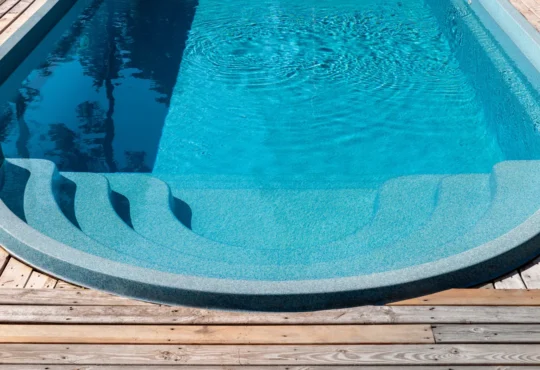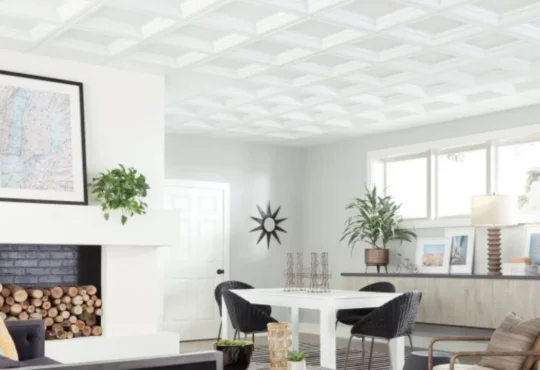The small space revolution is transforming homes and lives. It is more popular because it’s expensive to live in big places. People are finding ways to make small spaces look amazing. One such idea is using peel and stick wall tiles. These tiles can make small places look great without spending a lot of money or time on big renovations.
Now, let’s see how picking the right tiles can make small spaces look amazing.
Strategic Selection: Choosing the Right Peel and Stick Wall Tiles

The patterns, colors, and materials of your peel and stick wall tiles will influence how your space is perceived. Cool hues like blue or green can make a room feel more expansive, while warm shades like red or orange will create a positive vibe. Shiny tiles will reflect light and add depth, while matte finishes offer classic elegance.
A study by Zillow found that homes with stylish, well-designed kitchens featuring unique backsplashes tend to sell for up to 4.6% more than expected. So choose tiles that align with your room’s purpose. For a kitchen backsplash, consider materials that are heat- and stain-resistant. In a bathroom, opt for tiles with moisture resistance.
With the power of choice in mind, let’s explore how selecting the right peel and stick wall tile can create optical illusions, making your small space feel more expansive.
Optical Illusions: Creating Depth and Expanding Space
As we uncover the secrets of optical illusions, it’s essential to consider the tactile dimension. Discover how texture and dimension can add a touch of luxury to your small space.
Strategically placed tiles can trick the eye, making a room appear larger than it is. The National Association of Home Builders suggests that using light-colored, reflective tiles can make a room feel more open and airy. You can also lay tiles in a brickwork pattern to create the illusion of width or height.
Installing tiles vertically can draw the eyes upward, making ceilings seem higher. Horizontal patterns will elongate walls, expanding a narrow kitchen or bathroom. Contrasting grout lines are another effective technique—dark grout against light tiles or vice versa. The grid effect makes room boundaries recede.
Carefully chosen proportions also influence perception. Long, thin subway-style tiles make walls look taller. Smaller mosaics will expand floors. Extra-large statement tiles counterintuitively make petite rooms feel grand.
3D tiles and tiles with a pronounced texture add protruding elements that cast shadows and create depth. This instantly enlarges a powder room, entryway, or hallway. Glossy glass or metallic tiles reflect light in various directions, bouncing it around the room for a spacious effect.
Incorporating decorative accents is another clever illusion. Thin borders, pretty medallions, or a marbled ceramic tile “rug” on the floor provide defined boundaries that make the overall area appear bigger. Just a few skillfully placed mosaic tiles as insets or backsplashes also maximize visual expanse.
Texture and Dimension: Adding a Touch of Luxury
While visual tricks have immense power, the tactile experience is equally important. Luxurious textures like tumbled stone, handmade ceramic, or embossed metal can transform a small space from mundane to spectacular. In a Houzz survey, 74% of respondents said they prioritize texture and dimension in home decor.
Unique 3D tiles create shadows and contours, adding architectural interest on a petite scale. Just a few professionally installed dimensional tiles can crown a small wall with captivating elegance. For tiny powder rooms, handpainted, glazed ceramic tiles will dazzle guests with artisanal charm. Thoughtfully placed metal or mother of pearl inlays enrich a kitchen backsplash with glistening style.
Beyond aesthetics, let’s delve into the functional benefits of peel and stick wall tiles, backed by their durability, moisture resistance, and ease of maintenance.
Beyond Aesthetics: Functional Benefits of Peel and Stick Wall Tiles
The decorative appeal of peel and stick wall tiles is abundantly evident. But these tiles offer tremendous functional perks as well. Made from materials like moisture-resistant PVC, they are ideal for kitchen backsplashes and bathroom installations. With groutless applications, keeping surfaces clean and hygienic is a breeze.
Unlike ceramic or natural stone tiles requiring regular sealing, peel and stick options are inherently resistant to stains, mold, and mildew. This makes them perfect for high-moisture areas prone to water splashes. Their non-porous surface deters grime and soap scum buildup.
Textured surfaces also cleverly conceal signs of wear and tear. Subtle stone and sand textures hide fingerprints and smudges. Meanwhile, glossy and mirrored finishes amplify light, making rooms feel cleaner.
Many peel and stick tiles have acrylic or vinyl coatings that allow for effortless maintenance using mild detergents. Compared to painted walls that require frequent touch-ups, durable tile surfaces retain their visual brilliance for years. Easy replacement of damaged tiles enables spot repairs and updates.
In addition to backsplashes, install peel and stick tiles on shower walls and tub surrounds. The waterproof properties prevent deterioration and leaks. Use sparkling glass mosaic tiles to brighten dark vanity areas. Apply stone-look tiles to upgrade boring laundry rooms. Let imagination and function guide your choices.
Installation Mastery: DIY or Professional Assistance?
Installing peel and stick wall tiles may sound straightforward. Simply peel off the backing and stick tiles to your surface—seamless and frustration-free. But in reality, a professional-quality installation requires meticulous alignment, cornering, surface prep, and precise execution.
According to a HomeAdvisor survey, homeowners can save an average of $1,000 by opting for DIY tile installation over hiring professionals. With some basic equipment like a level, tile cutter, and grout float, homeowners can tackle simple, smaller-scale projects. But large areas or intricate patterns may warrant calling in an installation expert. Their experience ensures impeccable placement and lasting adhesion.
While contemplating installation, don’t forget the importance of sustainability. Explore how eco-friendly peel and stick wall tile options align with your design choices.
Sustainability Matters: Eco-Friendly Options
In an era where consumers are ever more eco-conscious, sustainability should be top of mind when selecting home decor. Many companies now offer peel and stick wall tiles made from recycled materials like crushed glass, reclaimed wood, and renewable bamboo.
Opting for water-based adhesives is safer for installers and the environment. Plus, tile packaging made from recyclable materials diverts waste from landfills. Eco-friendly manufacturing processes like solar production also reduce the carbon footprint of peel and stick tiles.
As we consider eco-conscious choices, let’s turn to real-life case studies that showcase the transformative potential of peel and stick wall tiles in small spaces.
Case Studies: Real-Life Transformations in Small Spaces
Jessie from San Diego revamped her cramped kitchen by installing an on-trend terrazzo peel and stick backsplash. The stylish marble and stone patters made her formerly dull kitchen look expensive and spacious. According to Remodeling Magazine, a minor kitchen remodel that includes updating backsplashes can have an average return on investment of 78.9%.
Marcus in Brooklyn used textured, 3D geometric tiles to refresh his outdated bathroom. The modern honeycomb tiles created an intricate focal wall behind the toilet, drawing the eye and making the tiny space feel grand.
Cassie gave her rental apartment bedroom a special touch with removable woven raffia-style tiles above the bed. The natural material added warmth and texture without damaging the walls. Upon moving out, the tiles peeled off without leaving a trace.
After witnessing these transformations, let’s shift our focus to maintaining the visual impact. Discover tips to ensure your peel and stick wall tiles stand the test of time.
Maintenance and Longevity: Preserving the Visual Impact
One major benefit of peel and stick wall tiles is their longevity and ease of maintenance. Regular dusting or wiping with a damp microfiber cloth removes surface debris and dirt buildup. For a deeper clean, use a mild pH-balanced cleaner diluted with water.
Avoid abrasive scouring pads or cleaning products containing acids, bleach, or ammonia as these can damage tile finishes. Also, take care when cleaning around grout lines. Aggressive scrubbing may loosen grout or adhesive.
Most high-performing peel and stick tiles are naturally resistant to moisture and everyday wear-and-tear. However, replacing individual tiles that become damaged over time is easy for spot repairs. Properly installed peel and stick tiles can upgrade your space for 5-10 years or longer.
With maintenance in mind, it’s time to address common questions that often arise when considering peel and stick wall tiles in small spaces. Let’s provide answers.
FAQs
Can peel and stick wall tiles be applied over existing tiles or wallpaper?
Peel and stick tiles are usually made to stick well on smooth and clean surfaces, and that includes old tiles or wallpaper.
But, if the surface is not smooth, you might need to make it smooth with drywall joint compound. Always make sure to check the instructions that come with the tiles.
Are peel and stick wall tiles suitable for high-moisture areas like bathrooms and kitchens?
Yes, you can use special peel and stick tiles made from a material called vinyl in places like bathrooms and kitchens. These tiles are waterproof, which means they don’t get ruined by water or steam. make sure to choose tiles that are made for places with water.
How do I remove peel and stick wall tiles without damaging the underlying surface?
Gently heat tiles with a hair dryer or heat gun to soften the adhesive, then slowly peel off each tile. Scrape off any adhesive residue using a plastic putty knife. Avoid harsh solvents or chemicals that could damage the wall. Work carefully to avoid tearing the drywall paper or existing tiles.
Having answered these questions, we’ve explored the full spectrum of maximizing visual impact in small spaces with peel and stick wall tiles. It’s time to recap and inspire your design journey.
Conclusion: Small Spaces, Big Impact
For homeowners and renters alike, peel and stick wall tiles unlock simple yet stunning transformations without renovations or permanent changes. With innovative textures, patterns, materials and shapes to choose from, you can create captivating feature walls, backsplashes, and accents that appear luxurious and spacious.
Care properly for your tiles and enjoy the visual impact for years. Ultimately, you have the power to coax the best from even the littlest of spaces.








